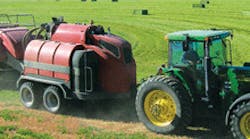The Dewpoint 6010 From Staheli West Pretreats Hay with Steam Before Baling, So Farmers Don’t Need No to Rely on Weather
AuomationDirect, www.automationdirect.com Moxa, www.moxa.com Staheli West, www.staheliwest.com Request free information via our Reader Service Web site at www.machinedesign.com/rsc |
A farm manager has developed a machine, the DewPoint 6110, that frees farmers from relying on Mother Nature to make their hay suitable for baling. Until Dave Staheli and his firm Staheli West, Cedar City, Utah, developed the DewPoint, farmers had to wait for the right dew conditions to moisten hay enough so that the nutritious leaves wouldn’t fall off during baling. Too much dew, or worse, rain, and the hay is too wet. Not enough dew, and most the leaves end up on the ground, not in the bales.
Inspired by a tortilla warmer that used steam, Staheli built a device that injects steam into the hay as it is picked up. The wheeled machine rides between the tractor and baler. It includes a low-pressure boiler to make steam, along with water and fuel tanks, a generator, water-feed system, and a DirectLogic DL06 PLC controller from AutomationDirect, Cumming, Ga. There’s also a C-More touchscreen control panel, also from AutomationDirect, in the tractor’s cab. The screen lets the driver control every aspect of the DewPoint, from start-up to shutdown.
The PLC controller accepts dozens of discrete and analog inputs, including boiler parameters, bale temperature, and crop flow as it moves through the DewPoint Hay Baler. Based on these variables, especially bale chamber pressure, the PLC determines the right amount of steam to inject via several distribution manifolds mounted in the hay baler. The goal is to get hay to moisture levels of 12 to 15% while baling. And the pressure exerted by the walls of the baling chamber (bale-chamber pressure) correlates well with bale moisture levels.
Staheli chose controllers from AutomationDirect based on price, technical support, and the wide variety of single-sourced components the firm offers that work well together. The machine also incorporates an OnCell Cellular IP modem from Moxa, Brea, Calif. It lets farm managers remotely monitor and control several DewPoints simultaneously. This is helpful when a farmer has inexperienced operators out in the field carrying out baling operations. It lets the farmer “look over the shoulder” of new operators and offer advice when needed.
Farms equipped with a DewPoint 6110 can bale any time of day or night, providing it isn’t raining and there isn’t too much dew on the fields. In the past, farmers had to wait for the right weather, then put a tractor and baler in the field to bale 40 to 60 acres. This means medium-sized hay farms (2,000 acres), often needed four sets of tractor and balers, with each baler rig costing $250,000. And in the course of a year, each baler might operate fewer than 100 hr. In contrast, the DewPoint lets hay farmers cut their capital costs from 1 million dollars to $400,000. It also gives them much more latitude in when they harvest and bale hay.
Not only is baling less expensive and more convenient, studies done at the University of Wisconsin found that leaf loss on hay baled with a DewPoint is only about half that of hay baled at night during prime dew conditions. Using the machine costs between $1 and $1.25/ton of hay, and that includes chemicals to treat the boiler water, and diesel fuel for the generator and to tow the DewPoint.
Why wet hay bales are fire hazards When hay is cut, it is not killed. The plant cells still breath and metabolize, releasing heat into the bale. This is usually no problem other than the bales lose nutritional value. But if the bales’ internal temperatures are high enough, and there’s enough moisture, bacteria on the hay can feed and multiply, bumping up temperatures to about 135°F. These temperatures, along with excess water, make prime breeding grounds for another form of bacteria which can, in turn, convert the hay into a porous carbon sponge and raise temperatures inside bales to 170°F. If this hay is then exposed to oxygen, it can self-ignite. |
